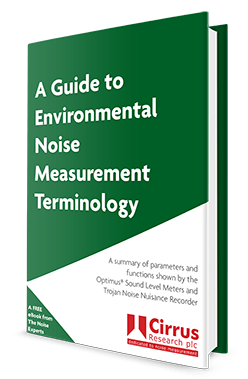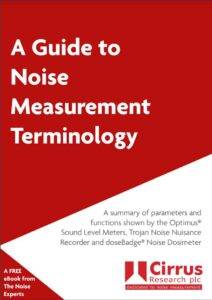A Guide to Environmental Noise Measurement Terminology [Free eBook]
The most advanced environmental noise monitors can measure more than 100 different noise parameters at the same time. Each parameter can tell you something different the environmental noise you’re monitoring. How do you remember what all this noise terminology means and what it does?
In our latest eBook, A Guide to Environmental Noise Measurement Terminology, we reveal the most common noise terminology used for monitoring environmental noise. We’ve included a brief explanation of each parameter and noise term to help you with your noise measurements.
What the Environmental Noise Terminology Guide includes:
- Key noise terms that every Environmental Health Officer needs to know
- Descriptions of all the noise terminology and parameters for environmental noise monitoring
- Explanations of the more general noise measurement terms used
- Reference guide for the Standards for Sound Level Meters and Acoustic Calibrators
- For Cirrus customers, a look at what the different View Screens on the Optimus® Sound Level Meter can show you
Example: Key Noise Term
1:1 &1:3 Octave Band Filters – When detailed information about a complex sound is needed, the frequency range can be split into sections, or frequency bands.
A sound level meter may provide 1:1 (or single) octave band filters or 1:3 (or third) octave band filters. An Octave is a frequency band where the highest frequency is twice the lowest frequency. For example, an octave filter with a centre frequency of 1kHz has a lower frequency of 707Hz and an upper frequency of 1.414kHz.
A Third Octave Band is 1/3 the width of an Octave Band.
An instrument with 1:1 octave band filters, such as the Optimus CR:162C, would typically provide 10 bands from 31.5Hz to 16kHz.
An instrument with 1:3 octave band filters, such as the Optimus CR:171B, would typically provide 33 bands from 12.5Hz to 20kHz although some
additional bands such as 6.3Hz, 8Hz and 10Hz may also be available.
Example: Noise Terminology and Parameters
Ln Values – Statistical analysis of noise levels. The n denotes the percentage exceedence, for example the value of L90 shows the noise level that was exceeded for 90% of the measurement duration.
Percentile level where n is between 0.01 and 99.9% calculated by Statistical Analysis. Ln values usually include a descriptor that shows the frequency weighting e.g. A-weighting and the time weighting e.g. Fast. The most common Ln values are LAF10 and LAF90.
Example: General Noise Measurement Term
Acoustic Fingerprint – An advanced system that allows triggers to be set up to start and stop audio recordings and markers in the Optimus Green and Trojan instruments.
The triggers can be made up of a number of rules which can be level, rate of change or tonal noise based and can use any parameter that is available in the instrument.
Check out the Environmental Noise Terminology Guide to expand your noise knowledge and the types of workplace noise measurements you can make.
Jaymee-lee Tolliday
Latest posts by Jaymee-lee Tolliday (see all)
- Turning Down the Volume: How the Trojan Noise Nuisance Recorder can help create a quieter world - 13th February 2024
- Festive Opening Hours 2023 - 6th December 2023
- Award of Excellence for Cloud-Based Monitoring Solutions 2023! - 20th November 2023

